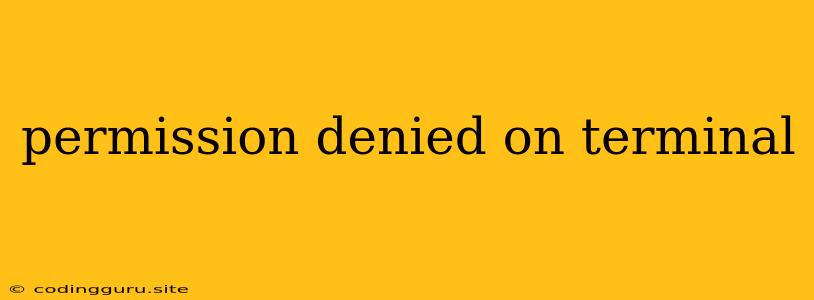Permission Denied on Terminal: A Common Problem and Its Solutions
The dreaded "permission denied" error on your terminal can be frustrating, but it's a common issue that has a variety of potential causes. This error often arises when you try to access, modify, or execute a file or directory that your user account doesn't have the necessary permissions for.
Understanding Permissions
Before diving into solutions, it's essential to understand how file permissions work in Unix-like systems (including macOS and Linux). Every file and directory has three sets of permissions:
- Read: Allows you to view the contents of a file or list the files within a directory.
- Write: Allows you to modify the contents of a file or create new files within a directory.
- Execute: Allows you to run a file (e.g., a script) or navigate into a directory.
These permissions are assigned to three different entities:
- Owner: The user who created the file or directory.
- Group: A group of users who have shared access to the file or directory.
- Others: All other users on the system who are not the owner or part of the group.
Each entity has a set of permissions represented by three characters:
- r: Read permission
- w: Write permission
- x: Execute permission
- -: No permission
For example, rw-r--r-- indicates the owner has read and write access, the group has only read access, and others have only read access.
Common Causes of "Permission Denied"
Here are some common scenarios where you might encounter "permission denied" errors:
- Trying to modify files in system directories: System directories like
/etcand/usr/binusually have strict permissions to prevent accidental changes that could compromise system stability. - Running executables that require root privileges: Certain commands and programs, like
apt-getorsystemctl, require administrator privileges to operate. - Accessing files created by another user: If you attempt to access a file owned by a different user without the necessary permissions, you'll get the "permission denied" error.
- Incorrect file ownership: Sometimes, files might have incorrect ownership or group assignments, leading to permission issues.
Solutions to "Permission Denied" Errors
Depending on the specific cause of the error, you can try different solutions:
1. Use sudo for Administrator Privileges
For tasks requiring administrator privileges, you can use the sudo command to elevate your privileges temporarily. This is often necessary when you're working with system files, installing software, or running privileged commands. For example:
sudo apt-get update
You'll be prompted for your password to confirm the command execution.
2. Change File Permissions
If you're attempting to access or modify a file that you own, you can change its permissions using the chmod command. For example:
chmod u+w myfile.txt
This command will grant write permission to the owner (you) for the file myfile.txt.
3. Change File Ownership
To change the owner of a file, use the chown command. For example:
chown yourusername:yourgroup myfile.txt
This command will change the owner of myfile.txt to your username and its group to your group.
4. Check Group Membership
If you're trying to access a file belonging to a specific group, ensure you're a member of that group. You can check your group memberships with the groups command.
5. Run a Script with the Appropriate User
If you're running a script that requires specific permissions, you can use the su command to switch to the appropriate user. For example:
su - username
This will log you in as the specified username, granting you access to its permissions. Remember to log out of the user account when you're finished.
6. Use a Different User Account
If you don't have sufficient permissions for a task, consider using a different user account with higher privileges. For example, if you're working on a development project, you might have a separate user account specifically for development tasks with the necessary permissions.
7. Restart Your Terminal
Sometimes, a simple restart of your terminal session can resolve permissions-related issues.
8. Update or Reinstall Software
If the error is related to a specific software, updating or reinstalling it might fix the issue.
9. Check System Logs for Further Clues
The system logs can provide valuable insights into the cause of permission errors. Check files like /var/log/syslog or /var/log/auth.log for any relevant messages.
10. Seek Help From Online Resources and Communities
If you're unable to resolve the issue yourself, you can seek assistance from online forums, documentation, or support communities dedicated to your operating system or software.
11. Consult with a System Administrator
For complex permission issues or if you suspect a security compromise, consider consulting with a system administrator or IT professional.
Troubleshooting Tips
- Be Specific: Provide as much detail as possible when reporting the error, including the command you're trying to execute, the files or directories involved, and any relevant error messages.
- Verify File Ownership: Use
ls -lto display detailed file information, including ownership and permissions. - Test Permissions with Different Users: If possible, try accessing the file or directory with different user accounts to isolate the issue.
- Use a Text Editor to View Permission Settings: Tools like
nanoorvimallow you to view and modify file permissions directly.
Example Scenario
Let's say you're trying to install a software package using apt-get, but you get a "permission denied" error. The solution here is likely to use sudo to elevate your privileges:
sudo apt-get install package-name
Important Notes:
- Be careful when working with system files and directories. Incorrect permissions can cause system instability or data loss.
- Always ensure you have a backup of your data before making any significant changes.
- If you're unsure about a command, consult with a system administrator or refer to the command's documentation.
Conclusion
"Permission denied" errors are a common occurrence in Unix-like systems, and understanding the concept of file permissions is essential for troubleshooting them. By following the solutions and tips outlined above, you can effectively overcome these errors and gain the necessary access to files and commands.
